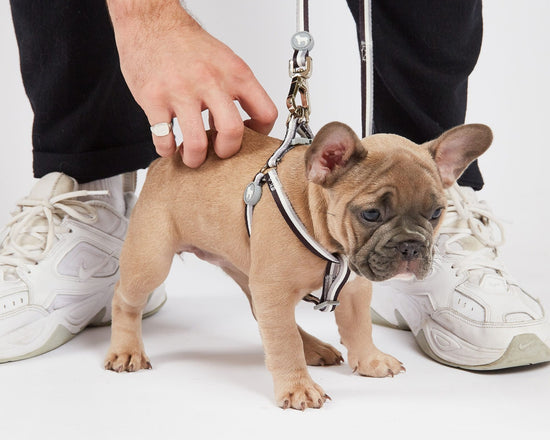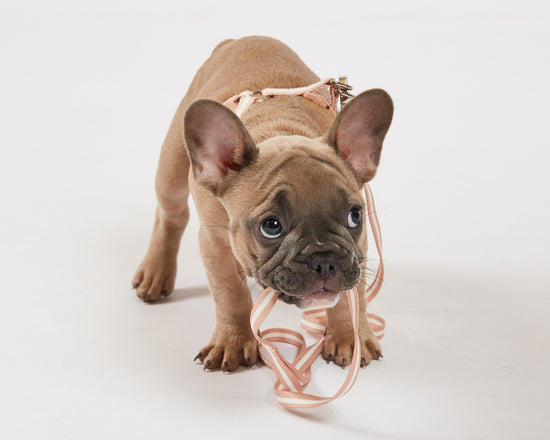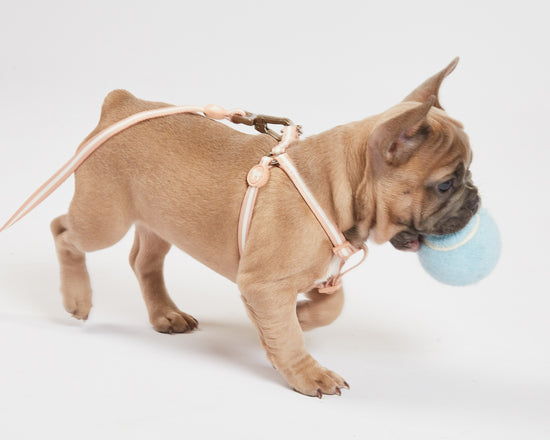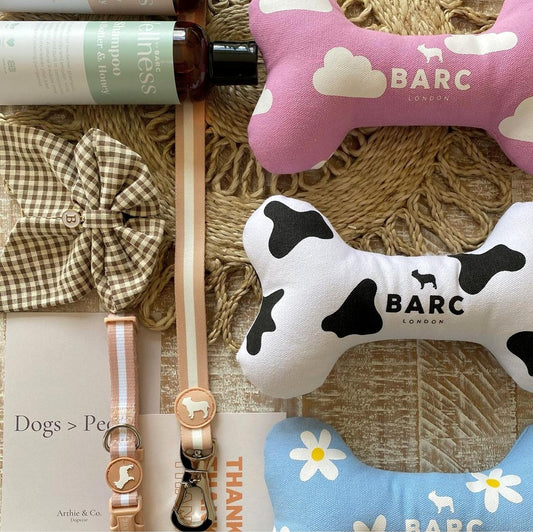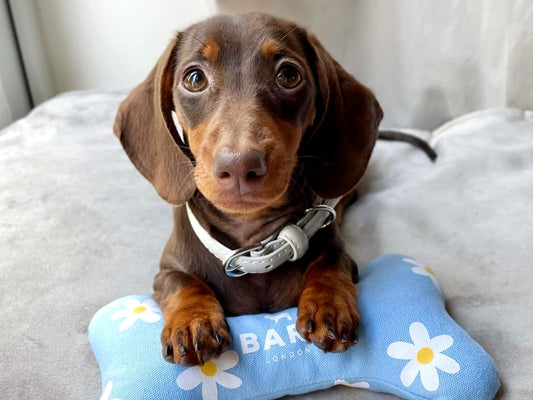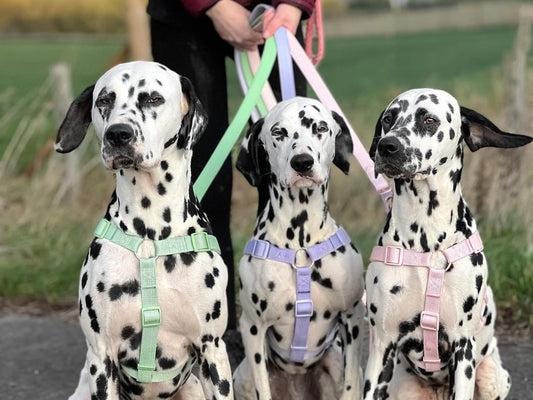Puppy Accessories Guide:
Barc London's puppy products size chart:
What should I do when I bring home a new puppy?
What do I need for a puppy?
A new puppy checklist:
- Identification tags
- Collars, leads and harnesses
- Toys, treats and teething
- Crates and bedding
- Coats and clothing
- Bowls and food
- Grooming
- Travel crate
Puppy products size chart:
| Barc London Puppy Products |
| Product & Recom. Sizes | Product Sizing | Puppy Measurement |
| Vegan Leather Collars (XS or S) |
Collar width (cm): 1.6 |
Neck size (cm): 17.5 - 23.5 or 25 - 31 |
| Fabric Collars (XS or S) |
Collar width (cm): 1 or 1.5 |
Neck size (cm): 20 - 28.5 or 28 - 42.5 |
|
Fabric Harnesses (XS or S) |
Strapping width (cm): 1 or 1.5 |
Chest size (cm): 28.5 - 40 or 36.5 - 49 |
| Vegan City Leads (XS or S) |
Lead length and width (cm): 143 x 1.6 (for both) |
NA |
| Fabric City Leads (XS or S) |
Lead length and width (cm): 100 x 1 or 100 x 1.5 |
NA |
| Puffer Coats (XS or S) | NA |
Chest size (cm): 45 or 55 |
| Raincoats (XS or S) | NA |
Chest size (cm): 38 or 52.5 Back size (cm): 25 or 35 |

What should I do when I bring home a new puppy?
Bringing a puppy home for the first time can be both exciting and daunting. The most important thing to remember is that your puppy will be entering an unfamiliar place, so you need to do everything possible to help pup feel safe and comfortable.
By ensuring you’ve properly prepared for your dog’s arrival, you’ll reduce the chance of anything going wrong.
What do I need for a puppy?
When you think about the sheer volume of things you need to cater to a puppy’s different needs, it can all seem a tad overwhelming.
Don’t be alarmed, it’s not as complicated as you think. We’re here to keep things nice and simple, and help your puppy prep get underway hiccup-free!
If you're unfamiliar with all this 'puppy stuff', you might find it helpful to use our new puppy checklist to make sure you don't forget anything along the way.
Barc London's new puppy checklist:
Making use of a new puppy checklist will help to ensure you have all the essential puppy accessories and are good to go. You can use our printable dog checklist online, or make a physical copy if you'd prefer.
Read through the list carefully and start puppy supply shopping as soon as you can, ticking off each item as you go.
Share this Image On Your Site
Please include attribution to https://www.barclondon.com/ with this graphic.
Puppy ID tags
Investing in a puppy ID tag is not only essential for your dog’s safety, it’s also a UK dog law under The Control of Dogs Order 1992. When buying your puppy’s ID tag, make sure it features:
- Your name and current address
- Your dog’s name
Puppy collars, leads and harnesses
A puppy collar will help your dog get into good habits, and provide somewhere for you to attach the identification tag to.
When choosing a puppy collar, make sure you pick one that is comfortable and the correct size.
As your puppy will be growing all the time, you should bear in mind that you’ll need to continually check that their collar still fits. When your puppy becomes a dog, you'll need to purchase them an adult collar.
💡 Top tip: To ensure your puppy collar isn’t too tight, make sure you can fit two fingers underneath it easily.
As well as a puppy collar, you’ll need to start thinking about investing in a puppy lead and puppy harness.
The lead you choose should not be too long, and at this stage, retractable leads are a no-no. Wait until your puppy has been lead trained for this.
We get a lot of customers asking if their puppies can wear harnesses, and the answer is yes!
A puppy can safely wear harnesses from eight weeks, and lots of people find these products beneficial to training.
💡 Top Tip: Just because your puppy can wear a harness from two months, that doesn't mean it's ready for walkies. Find out when to take a puppy for a walk in our guide.
Puppy teething, toys and treats
When puppies are teething, they can be in a lot of discomfort, so puppy chew toys are a good way to provide some relief for sore gums.
You’re also going to need to stock up on treats to reward your pup’s good behaviour, but it’s important to make sure the treats you choose have the right nutrients to give your dog a balanced diet from an early age.
Avoid any treats that are too hard - soft dog chews can be a great alternative. Make sure you take time to research what your puppy can and can’t eat.
When it comes to choosing toys, remember that puppies are full of energy, and it takes time for them to learn how to play gently.
Be careful to observe your puppy’s chewing behaviour over time to make sure the toys you choose don’t become choking hazards.
When searching for puppy toys, think about:
- Quality of materials
- Strength and durability
- Toy size (it should never be able to fit into your puppy’s mouth entirely)
Puppy crates and bedding
Investing in a puppy crate will help your new dog get into a good night-time routine with better sleeping habits. Your puppy’s crate should be big enough that it will have room to grow into it.
Once you’ve chosen a quality crate, you need to make the space comfortable. To do this, take time to search for bedding, blankets and toys that are suitable for puppies.
Puppy coats and clothing
When shopping for your pup, you might want to consider getting a puppy raincoat for wet dog walks.
Puppies tend to benefit from the extra layer of protection because in the younger months they haven't yet developed their full coat.
In cold, wet and windy temperatures your puppy may be more susceptible to getting sick. Find out more about waterproof coats for dogs.
Puppy bowls and feeding
Your puppy’s feeding schedule is an important consideration, and his or her diet should be carefully considered to ensure the right nutritional requirements for growth and development are being achieved.
Every dog is different, so it can be wise to speak with a vet to get specific food recommendations and advice.
You might find feeding time easier with a non-slip puppy bowl or slip resistant mat. These products can help with mess, and prevent your dog from getting into bowl pushing habits.
Puppy grooming
Regular puppy grooming will help ensure your dog stays clean, comfortable and healthy. What's more, starting these grooming routines at home from a young age can also help your puppy get into good future habits, and help when it’s time to visit a professional groomer.
The most important areas to focus on are your dog’s teeth and coat - which should both receive a good brush! You should also make sure that the dog grooming products you choose are chemical-free and suitable for puppies. Work through the checklist to ensure you have everything you need.
Puppy travelling
Though travelling in a car can be a stressful experience for a puppy, there are steps you can take to ensure they are comfortable and feel safe.
It’s likely you’ll need to bring pup home in a car, so this is an important factor to consider before you pick up your puppy.
Once you’ve bought a puppy crate for the car, it can be placed in the boot or the back of the car, but never in the front.
As with the sleeping crate, the car crate should be stocked with comfy bedding, and you’ll want to have newspaper and towels to hand in case your puppy needs the toilet or gets travel sickness.
How to puppy proof my house:
Puppy proofing your house is one of the first things you should do before your dog’s arrival. You’ll soon find out that puppies are incredibly curious, and he or she will likely want to explore their new surroundings.
By puppy proofing your home, you’re preventing your dog from getting into any danger, and decreasing the likelihood of accidents happening. Prepare for your bundle of energy to get home by:
- Using baby gates to proof any areas of the house that you don’t want your puppy to access
- Walk around your house and ensure that anything dangerous or breakable is out of your pup’s reach
- Unplug all electrical cords as these can be chewing and shock hazards for young dogs
- Make sure all medications and food items are out of harm’s way
- Get rid of poisonous houseplants that your puppy could eat. For example, aloe vera can harm a dog’s digestive system and peace lilies cause irritation to lips and tongue, impacting their ability to breathe and swallow
- Keep all sharp objects away from puppy areas. If you have children, ensure arts and crafts or unsuitable toys are kept in a separate area that’s gated off
